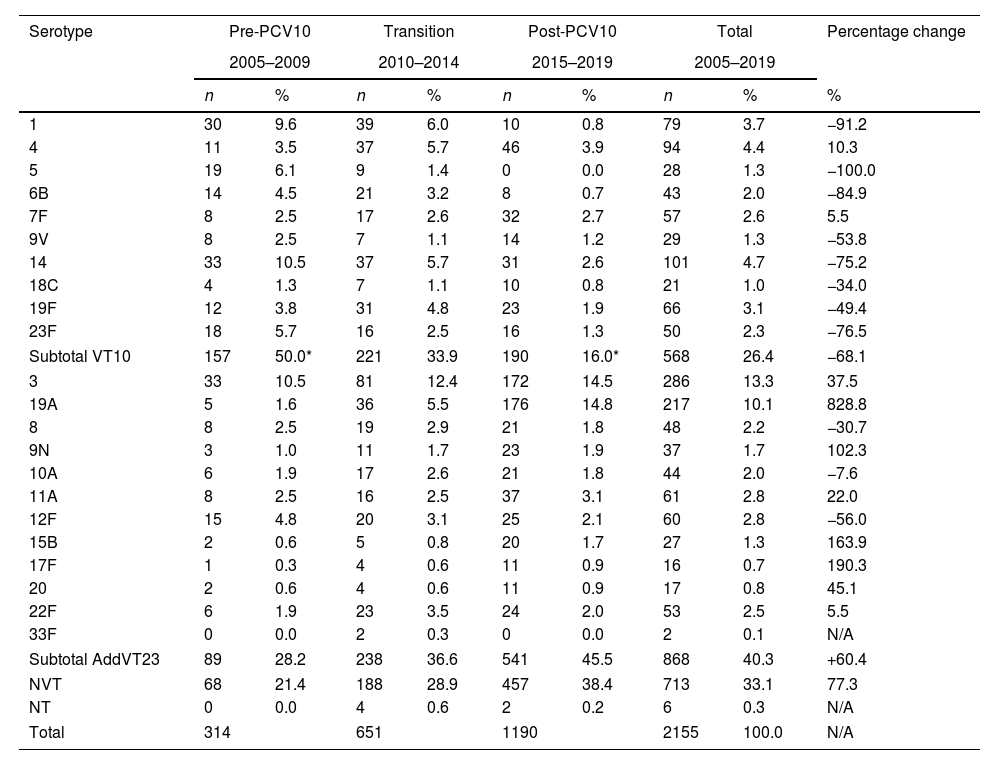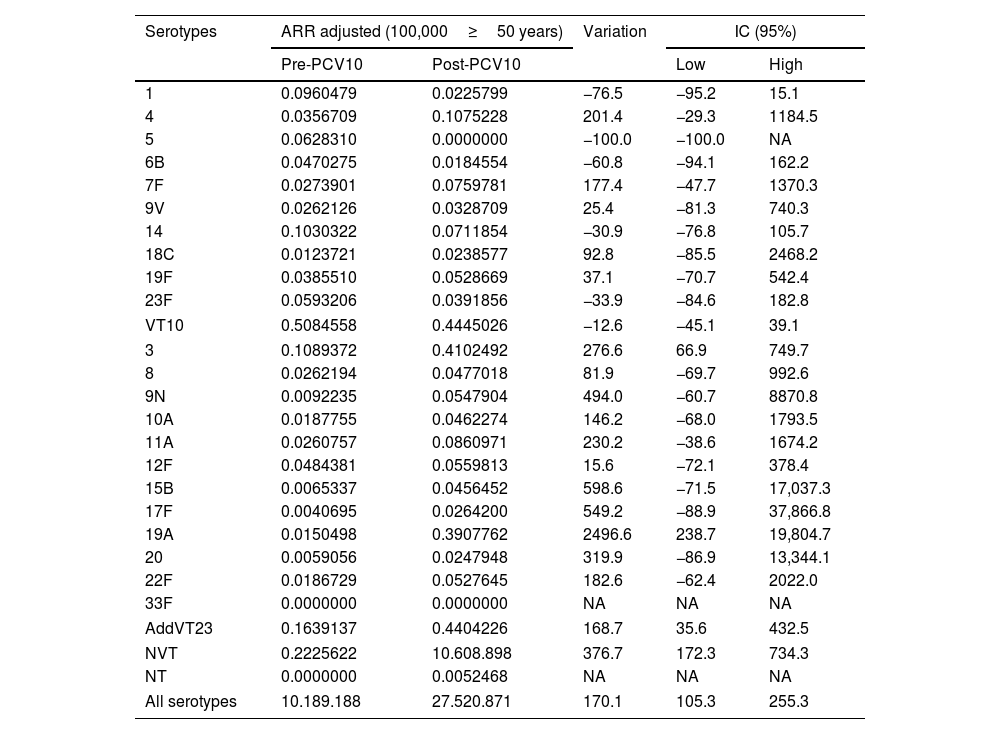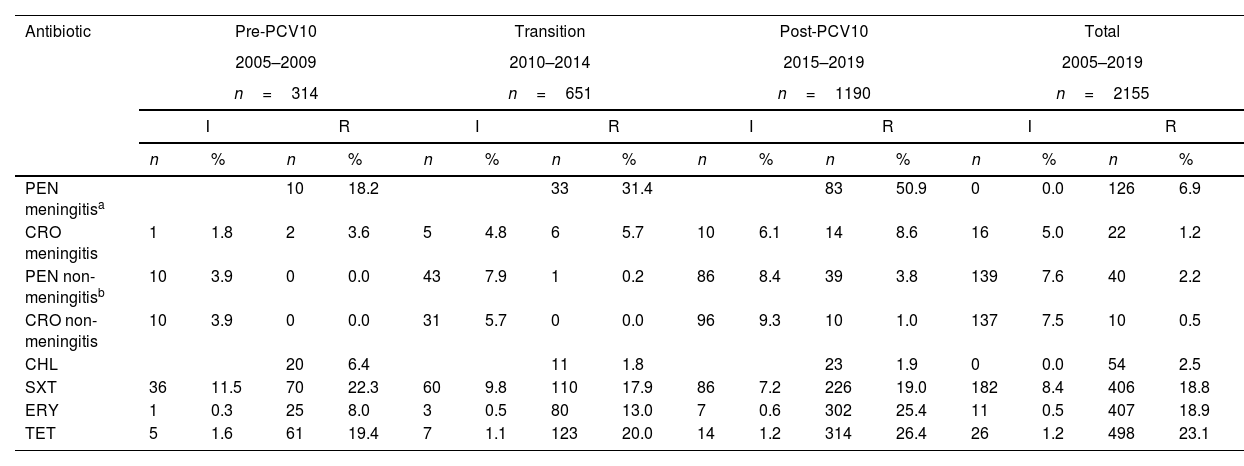The introduction of pneumococcal conjugate vaccine (PCV) into childhood vaccination programmes has reduced the prevalence of vaccine serotypes (VTs) that cause invasive pneumococcal disease (IPD) in children. In the elderly population, an impact has also been seen through indirect protection (herd effect). The aim of this study was to estimate the changes in serotype distribution and antimicrobial susceptibility of Streptococcus pneumoniae isolates recovered from adult IPD and to evaluate the indirect effect of immunization with PCV10 based on laboratory records by analyzing the period from 2005 to 2019 for six years before and eight years after the universal PCV10 administration to Colombian children.
MethodsA total of 2204 S. pneumoniae isolates from adults (≥50 years) with IPD were analyzed. The analysis examined the percentage changes in proportions (prevalence) and percentage variations in population rates (annual reported rates – ARR) of VTs between the pre-PCV10 (2005–2009) and post-PCV10 (2015–2019) periods.
ResultsThe findings were (1) evidence of a significant percentage decrease of pneumococcal VT10 causing IPD in adults (50% pre-PCV10 and 16% post-PCV10); (2) significant increase of serotype 19A (from 1.6% to 14.8%) and less important increase of serotype 3 (from 10.5% to 14.5%) and non-vaccine serotypes (NVT) (from 21.4% to 38.4%) non-significant; and (3) meningitis and non-meningitis multidrug resistant isolates associated with serotype 19A. An improvement in the surveillance system is associated with the immunization of children, as noted by the increased ARRs across the analysis period.
ConclusionsOur results show the indirect impact of PCV10 vaccination in children on the VT10 distribution and antimicrobial resistance of S. pneumoniae causing IPD in Colombian adults over 50 when comparing the pre-PCV10 (2005–2009) and post-PCV10 (2015–2019) periods.
La introducción de las vacunas neumocócicas conjugadas (pneumococcal conjugate vaccines [PCV]) en los programas de vacunación infantil ha reducido la prevalencia de los serotipos vacunales (vaccine serotypes [VT]) que causan la enfermedad neumocócica invasiva (ENI) en los niños. En la población adulta también se ha visto un impacto a través de la protección indirecta (efecto rebaño). El objetivo de este estudio fue estimar los cambios en la distribución de serotipos y la susceptibilidad antimicrobiana de aislamientos de Streptococcus pneumoniae recuperados de ENI de adultos y evaluar el efecto indirecto de la inmunización con PCV10 con base en registros de laboratorio mediante el análisis del período de 2005 a 2019, seis años antes y ocho años después de la administración universal de PCV10 a niños colombianos.
MétodosSe analizaron un total de 2.204 aislamientos de S. pneumoniae de adultos (≥50años) con ENI. Se examinaron los cambios porcentuales en las proporciones (prevalencia) y las variaciones porcentuales en las tasas poblacionales (tasas anuales informadas [annual reported rates, ARR]) de VT entre los períodos anterior (2005-2009) y posterior a PCV10 (2015-2019).
ResultadosLos hallazgos fueron: 1) evidencia de una disminución porcentual significativa de los serotipos incluidos en la VT10 neumocócica que causa ENI en adultos (50% pre-PCV10 y 16% post-PCV10); 2) aumento significativo del serotipo 19A (del 1,6% al 14,8%) y aumento menos importante del serotipo 3 (del 10,5% al 14,5%) y de aislados no tipables (NVT) (del 21,4% al 38,4%) no significativo, y 3) aislamientos multirresistentes de meningitis y no-meningitis asociados con el serotipo 19A. Se asoció una mejora en el sistema de vigilancia junto con la inmunización de los niños, como se observa en el aumento de las ARR durante el periodo de análisis.
ConclusionesEstos resultados demuestran el impacto indirecto de la vacunación con PCV10 en niños en la distribución de serotipos VT10 y en la resistencia a antimicrobianos de S. pneumoniae causante de ENI en adultos colombianos mayores de 50 años, cuando se compara el periodo pre-PCV10 (2005-2009) con el post-PCV10 (2015-2019).
Article
Socio de la Sociedad Española de Enfermedades Infecciosas y Microbiología Clínica

Para acceder a la revista
Es necesario que lo haga desde la zona privada de la web de la SEIMC, clique aquí











